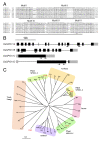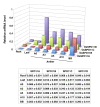The double-stranded break-forming activity of plant SPO11s and a novel rice SPO11 revealed by a Drosophila bioassay
- PMID: 22248237
- PMCID: PMC3273433
- DOI: 10.1186/1471-2199-13-1
The double-stranded break-forming activity of plant SPO11s and a novel rice SPO11 revealed by a Drosophila bioassay
Abstract
Background: SPO11 is a key protein for promoting meiotic recombination, by generating chromatin locus- and timing-specific DNA double-strand breaks (DSBs). The DSB activity of SPO11 was shown by genetic analyses, but whether SPO11 exerts DSB-forming activity by itself is still an unanswered question. DSB formation by SPO11 has not been detected by biochemical means, probably because of a lack of proper protein-folding, posttranslational modifications, and/or specific SPO11-interacting proteins required for this activity. In addition, plants have multiple SPO11-homologues.
Results: To determine whether SPO11 can cleave DNA by itself, and to identify which plant SPO11 homologue cleaves DNA, we developed a Drosophila bioassay system that detects the DSB signals generated by a plant SPO11 homologue expressed ectopically. We cytologically and genetically demonstrated the DSB activities of Arabidopsis AtSPO11-1 and AtSPO11-2, which are required for meiosis, in the absence of other plant proteins. Using this bioassay, we further found that a novel SPO11-homologue, OsSPO11D, which has no counterpart in Arabidopsis, displays prominent DSB-forming activity. Quantitative analyses of the rice SPO11 transcripts revealed the specific increase in OsSPO11D mRNA in the anthers containing meiotic pollen mother cells.
Conclusions: The Drosophila bioassay system successfully demonstrated that some plant SPO11 orthologues have intrinsic DSB activities. Furthermore, we identified a novel SPO11 homologue, OsSPO11D, with robust DSB activity and a possible meiotic function.
Figures





Similar articles
-
Advances Towards How Meiotic Recombination Is Initiated: A Comparative View and Perspectives for Plant Meiosis Research.Int J Mol Sci. 2019 Sep 23;20(19):4718. doi: 10.3390/ijms20194718. Int J Mol Sci. 2019. PMID: 31547623 Free PMC article. Review.
-
Arabidopsis SPO11-2 functions with SPO11-1 in meiotic recombination.Plant J. 2006 Oct;48(2):206-16. doi: 10.1111/j.1365-313X.2006.02867.x. Plant J. 2006. PMID: 17018031
-
Molecular characterisation of two paralogous SPO11 homologues in Arabidopsis thaliana.Nucleic Acids Res. 2000 Apr 1;28(7):1548-54. doi: 10.1093/nar/28.7.1548. Nucleic Acids Res. 2000. PMID: 10710421 Free PMC article.
-
The catalytically active tyrosine residues of both SPO11-1 and SPO11-2 are required for meiotic double-strand break induction in Arabidopsis.Plant Cell. 2007 Oct;19(10):3090-9. doi: 10.1105/tpc.107.054817. Epub 2007 Oct 26. Plant Cell. 2007. PMID: 17965269 Free PMC article.
-
A new light on the meiotic DSB catalytic complex.Semin Cell Dev Biol. 2016 Jun;54:165-76. doi: 10.1016/j.semcdb.2016.02.025. Epub 2016 Mar 16. Semin Cell Dev Biol. 2016. PMID: 26995551 Review.
Cited by
-
Advances Towards How Meiotic Recombination Is Initiated: A Comparative View and Perspectives for Plant Meiosis Research.Int J Mol Sci. 2019 Sep 23;20(19):4718. doi: 10.3390/ijms20194718. Int J Mol Sci. 2019. PMID: 31547623 Free PMC article. Review.
-
OsSDS is essential for DSB formation in rice meiosis.Front Plant Sci. 2015 Feb 3;6:21. doi: 10.3389/fpls.2015.00021. eCollection 2015. Front Plant Sci. 2015. PMID: 25691887 Free PMC article.
-
Engineering meiotic recombination pathways in rice.Plant Biotechnol J. 2019 Nov;17(11):2062-2077. doi: 10.1111/pbi.13189. Epub 2019 Jul 2. Plant Biotechnol J. 2019. PMID: 31199561 Free PMC article. Review.
-
Heterologous Complementation of SPO11-1 and -2 Depends on the Splicing Pattern.Int J Mol Sci. 2021 Aug 28;22(17):9346. doi: 10.3390/ijms22179346. Int J Mol Sci. 2021. PMID: 34502253 Free PMC article.
-
Crossover interference mechanism: New lessons from plants.Front Cell Dev Biol. 2023 May 19;11:1156766. doi: 10.3389/fcell.2023.1156766. eCollection 2023. Front Cell Dev Biol. 2023. PMID: 37274744 Free PMC article. Review.
References
Publication types
MeSH terms
Substances
LinkOut - more resources
Full Text Sources
Molecular Biology Databases
Research Materials

